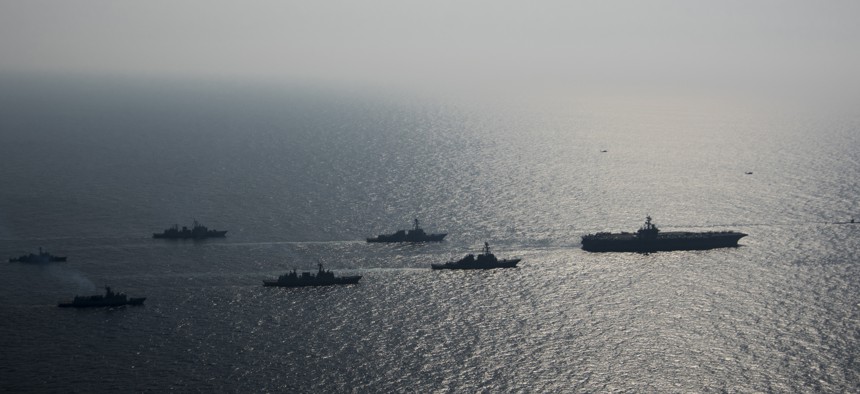
U.S. Navy and Republic of Korea Navy ships steam in formation during exercise Foal Eagle 2017. U.S. Navy / Mass Communication Specialist 2nd Class Z.A. Landers
How Postponing a Wargame Helped Create a Diplomatic Opening
Delaying Foal Eagle 2018 made an underappreciated contribution toward the first meeting of U.S. and North Korean heads of state.
U.S. and South Korean officials credit the U.S. strategy of maximum pressure and “zero concessions” for the sudden diplomatic movements by North Korea, including the Trump-Kim meeting planned for this spring. Less appreciated is their unusual decision in January to postpone a major annual wargame, which facilitated the recent talks between North and South Korea that led to this point. While the temporary suspension of Foal Eagle may not have been a concession per se, it did represent an important policy shift, and an effective use of military exercises as a bargaining chip. In essence, the “maximum pressure” strategy may have succeeded only because the pressure was relieved, apparently at just the right moment.
For nearly four decades, U.S. and South Korean forces have conducted large-scale annual exercises to maintain operational readiness and improve the allies’ interoperability and command-and-control capabilities. Foal Eagle involves hundreds of thousands of troops, including naval, air, and special operations units. Last year’s edition, for example, was primarily intended to strengthen the alliance and deter North Korean aggression, but also included exercises “to preemptively ‘detect, defend, disrupt and destroy’ North Korean nuclear and missile facilities.” Pyongyang despises the annual drills, and has consistently used them to justify its threats and missile tests by accusing the U.S. and South Korea of saber-rattling and preparing to invade.
Last year, the U.S. repeatedly rejected Chinese proposals for a “dual suspension” agreement: a suspension of North Korean missile tests in exchange for the suspension of U.S.-ROK military exercises. This approach was previously proposed by the North Koreans in 2015, but the U.S. understandably refused to link routine drills with nuclear testing. In August 2017, the annual Ulchi-Freedom Guardian drills took place amid a series of North Korean missile tests, followed by its most powerful nuclear test to date. The idea resurfaced last November, when a spokesman for China’s Foreign Ministry argued that the proposal was “the most realistic, viable and reasonable solution in the current situation” (adding that “it’s only the first step, not the end”). The Trump administration disagreed, pointing to the failure of similar agreements in the 1990s.
Instead, and following North Korea’s provocative late-November launch of an ICBM into Japanese waters, the U.S. kept up the pressure with Vigilant Ace, an exercise whose 230-plus aircraft included F-22s stealth fighters, F-35s, and B-1B bombers. Both the tempo of the drills and the capabilities of the units contributed to the sense of escalation toward “maximum pressure.” By the end of 2017, confrontation seemed all but inevitable.
However, in early January, President Trump agreed to South Korea’s request to postpone Foal Eagle. A White House statement said the move would “de-conflict the Olympics and our military exercises so that United States and Republic of Korea forces can focus on ensuring the security of the Games.” While Defense Secretary James Mattis said the decision was largely about logistics — keeping the massive movements of military forces from interfering with the Olympics — President Moon characterized the move “as an olive branch to North Korea.”
Aside from diplomatic isolation, economic sanctions, and forceful rhetoric, the U.S. has few options short of war to compel North Korea to abandon its nuclear weapons program. Military exercises thus have an important place in the diplomatic arsenal – they send a clear, credible signal of commitment and reinforce the deterrent effect of U.S. forces stationed in the theater. In this instance, the U.S. and South Korea also used them to exert pressure and gain diplomatic leverage by demonstrating preparedness for worst-case contingencies, and ostensibly to make a symbolic gesture of good will.
By postponing Foal Eagle at the behest of South Korea, the U.S. displayed confidence and restraint, de-escalated tensions on the peninsula, and created an opening for diplomacy and dialogue in the context of the Olympic Games. South Korean National Security Advisor Chung has said that Kim now claims to be committed to denuclearization, and that he will refrain from further nuclear and missile testing. He also said Kim has accepted the continuation of U.S.-South Korean military exercises, now planned to begin at the end of March.
The volatility of the situation is difficult to overstate, and there remain significant hurdles to denuclearizing North Korea, not to mention resolving the Korean War. The U.S. has historical cause for skepticism about Pyongyang’s ability to negotiate in good faith, and North Korea will undoubtedly continue to complain about U.S. military presence and activity in the region. Nevertheless, the recent overtures from both sides represent rare signs of progress. It appears for the moment that a de facto dual suspension agreement has broken the cycle of tit-for-tat military drills and tests, and may lead to direct talks between the heads of state of the U.S. and North Korea for the first time. This potential diplomatic breakthrough should be partly attributed to the successful employment of military exercises as a tool of coercive diplomacy.



